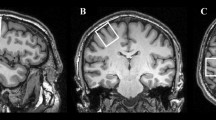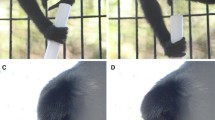Abstract
Few studies have examined interactions between hand preference and target laterality preference when subjects are permitted unrestricted choices of both hand and target at the same time. We therefore trained three monkeys to perform a task in which different types of choices were presented in different trials. In some trials the monkey chose between targets presented simultaneously to the right and left, while being required to use a specific hand. In these trials, the monkeys preferentially chose the target ipsilateral to the required hand. In other trials, the monkey chose between its right or left hand to retrieve a single target presented either on the right or on the left. In these trials, each monkey showed a consistent pattern of hand preference whether the target was presented on the right or left. In still other trials, the monkey chose both which hand to use and which target to retrieve. In these trials, the choices made by each monkey reflected its individual pattern of hand preference, plus a tendency to choose the target ipsilateral to the preferred hand, with little additional evidence of preference for target laterality. These patterns of laterality preference were similar regardless of whether a cue instructing which hand(s) the monkey could use preceded or followed a cue indicating on which side(s) the target(s) would appear. If the monkeys were permitted to use a strategy in which retrieving the target on a given side could increase the amount of food retrieved per trial, however, the choices made were biased strongly by that strategy. We conclude that when lateralized targets are equivalent, lateralized choices are biased primarily by hand preference and secondarily by a preference to retrieve a target ipsilateral to the preferred hand.




Similar content being viewed by others
References
Annett M (2004) Hand preference observed in large healthy samples: classification, norms and interpretations of increased non-right-handedness by the right shift theory. Br J Psychol 95:339–353
Annett M, Annett J (1991) Handedness for eating in gorillas. Cortex 27:269–275
Bowers D, Heilman KM (1980) Pseudoneglect: effects of hemispace on a tactile line bisection task. Neuropsychologia 18:491–498
Bryden PJ, Kay CA (2002) Hand preference in simultaneous unimanual tasks: a preliminary examination. Brain Cogn 48:284–287
Deuel RK, Dunlop NL (1980) Hand preferences in the rhesus monkey. Implications for the study of cerebral dominance. Arch Neurol 37:217–221
Ellis SJ, Ellis PJ, Marshall E (1988) Hand preference in a normal population. Cortex 24:157–163
Engel KC, Soechting JF (2003) Interactions between ocular motor and manual responses during two-dimensional tracking. Prog Brain Res 142:141–153
Gabbard C, Helbig CR (2004) What drives children’s limb selection for reaching in hemispace? Exp Brain Res 156:325–332
Gabbard C, Rabb C, Gentry V (1998) Attentional stimuli and programming hand selection: a developmental perspective. Int J Neurosci 96:205–215
Gabbard C, Tapia M, Helbig CR (2003) Task complexity and limb selection in reaching. Int J Neurosci 113:143–152
Gordon J, Ghilardi MF, Cooper SE, Ghez C (1994) Accuracy of planar reaching movements. II. Systematic extent errors resulting from inertial anisotropy. Exp Brain Res 99:112–130
Gribble PL, Everling S, Ford K, Mattar A (2002) Hand-eye coordination for rapid pointing movements. Arm movement direction and distance are specified prior to saccade onset. Exp Brain Res 145:372–382
Heilman KM, Jeong Y, Finney GR (2004) Spatial cognition. Neurology 63:1994–1996
Hopkins WD, Washburn DA, Rumbaugh DM (1989) Note on hand use in the manipulation of joysticks by rhesus monkeys (Macaca mulatta) and chimpanzees (Pan troglodytes). J Comp Psychol 103:91–94
Jewell G, McCourt ME (2000) Pseudoneglect: a review and meta-analysis of performance factors in line bisection tasks. Neuropsychologia 38:93–110
Lehman RA (1980a) Distribution and changes in strength of hand preference of cynomolgus monkeys. Brain Behav Evol 17:209–217
Lehman RA (1980b) Persistence of primate hand preference despite initial training to the contrary. Behav Brain Res 1:547–551
MacNeilage PF, Studdert-Kennedy MG, Lindblom B (1987) Primate handedness reconsidered. Behav Brain Sci 10:247–303
Mittra ES, Fuentes A, McGrew WC (1997) Lack of hand preference in wild Hanuman langurs (Presbytis entellus). Am J Phys Anthropol 103:455–461
Oldfield RC (1971) The assessment and analysis of handedness: the Edinburgh inventory. Neuropsychologia 9:97–113
Scherberger H, Goodale MA, Andersen RA (2003) Target selection for reaching and saccades share a similar behavioral reference frame in the macaque. J Neurophysiol 89:1456–1466
Schieber MH (2000) Inactivation of the ventral premotor cortex biases the laterality of motoric choices. Exp Brain Res 130:497–507
Snyder LH, Calton JL, Dickinson AR, Lawrence BM (2002) Eye-hand coordination: saccades are faster when accompanied by a coordinated arm movement. J Neurophysiol 87:2279–2286
Spinozzi G, Cacchiarelli B (2000) Manual laterality in haptic and visual reaching tasks by tufted capuchin monkeys (Cebus apella). An association between hand preference and hand accuracy for food discrimination. Neuropsychologia 38:1685–1692
Stins JF, Kadar EE, Costall A (2001) A kinematic analysis of hand selection in a reaching task. Laterality 6:347–367
Stins JF, Michaels CF (1997) Stimulus-target compatibility for reaching movements. J Exp Psychol Hum Percept Perform 23:756–767
Warren JM (1980) Handedness and laterality in humans and other animals. Physiol Psychol 8:351–359
Westergaard GC, Lussier ID, Higley JD (2001) Between-species variation in the development of hand preference among macaques. Neuropsychologia 39:1373–1378
Acknowledgements
The authors thank Katherine Shen for technical assistance, Marsha Hayles for editorial comments, and Gil Rivlis for assistance with data analysis. This work was supported by grants NS40082 and NS048328 from the National Institute of Neurologic Disorders and Stroke.
Author information
Authors and Affiliations
Corresponding author
Rights and permissions
About this article
Cite this article
Gardinier, J., Franco, V. & Schieber, M.H. Interactions between lateralized choices of hand and target. Exp Brain Res 170, 149–159 (2006). https://doi.org/10.1007/s00221-005-0193-9
Received:
Accepted:
Published:
Issue Date:
DOI: https://doi.org/10.1007/s00221-005-0193-9




